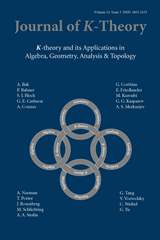Crossref Citations
This article has been cited by the following publications. This list is generated based on data provided by Crossref.
Biglari, Shahram
2013.
On lambda operations on mixed motives.
Journal of K-Theory,
Vol. 12,
Issue. 2,
p.
381.
Peter, Tobias J.
2013.
Prime Ideals of Mixed Artin-Tate Motives.
Journal of K-Theory,
Vol. 11,
Issue. 2,
p.
331.
Mazza, C.
and
Weibel, C.
2013.
Schur-finiteness in λ-rings.
Journal of Algebra,
Vol. 374,
Issue. ,
p.
66.


